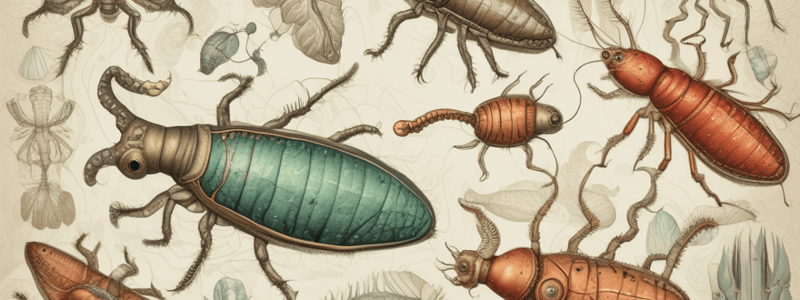Podcast
Questions and Answers
What percentage of animals in the world are invertebrates?
What percentage of animals in the world are invertebrates?
- 100%
- 50%
- 75%
- 95% (correct)
What do invertebrates not have?
What do invertebrates not have?
- A brain
- Skin
- A backbone (correct)
- A heart
What do arthropods have?
What do arthropods have?
- A shell
- Segmented bodies (correct)
- Soft bodies
- Jointed arms
What is the largest group of arthropods?
What is the largest group of arthropods?
What do most arthropods have?
What do most arthropods have?
What is the second largest group of invertebrates?
What is the second largest group of invertebrates?
What do mollusks have?
What do mollusks have?
Which of the following is NOT a characteristic of invertebrates?
Which of the following is NOT a characteristic of invertebrates?
What is the purpose of an exoskeleton?
What is the purpose of an exoskeleton?
Why do invertebrates often have simple bodies?
Why do invertebrates often have simple bodies?
Flashcards are hidden until you start studying
Study Notes
Invertebrate Definition
- Invertebrates make up at least 95% of all animals in the world.
- The common characteristic among all invertebrates is the absence of a backbone.
- Invertebrates have soft, simple, and often small bodies due to the lack of bone support.
- They are also cold-blooded, meaning their body temperature changes with the environment.
Arthropods
- Arthropods have segmented bodies and are the largest group of invertebrates.
- They can live on land (spiders, insects) or in water (crayfish, crabs).
- Insects are the largest group of arthropods and many can fly.
- Arthropods have jointed legs or limbs for easier movement.
- Most arthropods have an exoskeleton, a tough outer skin or shell that protects their body.
Mollusks
- Mollusks have soft bodies and live on land or in water.
- Many mollusks have shells to protect their bodies (snails, oysters, clams, scallops).
- Some mollusks do not have shells (octopus, squid, cuttlefish).
Other Invertebrates
- Coelenterates (jellyfish, sea anemone) have soft bodies and stinging tentacles.
- Echinoderms (starfish, sea urchin) are spiny sea creatures that live only in the ocean.
- Sponges are invertebrates that attach themselves to other things in the water and cannot walk, swim, or fly.
- Annelid worms (earthworms, leeches) are also invertebrates.
- Protozoa and flatworms are invertebrates that are too small to be seen without a microscope.
Studying That Suits You
Use AI to generate personalized quizzes and flashcards to suit your learning preferences.




